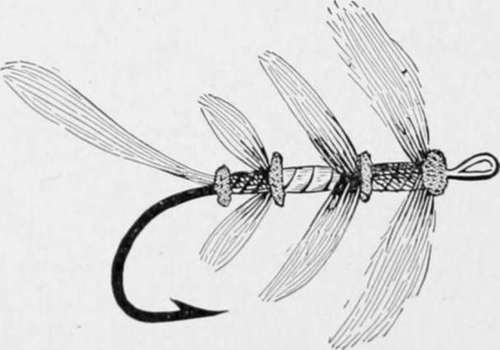Black Bass Flies
Description
This section is from the book "American Game Fishes", by W. A. Perry. Also available from Amazon: American Game Fishes: Their Habits, Habitat, and Peculiarities; How, When, and Where to Angle for Them.
Black Bass Flies
La Belle
Tail
White and scarlet.
Tag
Silver and scarlet silk.
Body
Blue silk, ribbed, silver.
Hackle
Blue.
Wings
White swan or goose.
White Miller
Tag
Silver.
Body
White chenille.
Hackle
White.
Wings
White swan or goose.
Polka
Tail
Brown and white.
Tag
Gold.
Body
Scarlet silk, ribbed, gold.
Hackle
Red.
Wings
Guinea-fowl.
Oriole
Tail
Black and yellow.
Tag
Gold.
Body
Black silk, gold tinsel ribbing.
Hackle
Black.
Wings
Orange (dyed goose).
Oconomowoc
Tail
Tag
Gold.
Body
Yellow silk (li^ht).
Hackle
White and dun.
Wings
Woodcock brown feather.
Lord Baltimore
Tail
Black.
Tag
Gold.
Body
Orange silk, ribbed, gold.
Hackle
Black.
Wings
Crow.
Henshall
Tail
Four fibers peacock tail feather.
Tag
Gold.
Body
Peacock herl.
Hackle
Dirty white.
Wings
Dove's wing (light drab).
Alexandra
Tail
Four fibers peacock tail feather.
Tag
Silver.
Body
Scarlet silk one-fourth, silver tinsel rest.
Hackle
White.
Wings
Fibers of peacock tail feather.
Triumph
Tail
Parrot.
Tag
Gold.
Body
Green silk one-half, light brown chenille one-half. Hackle,-Black.
Wings
Crow.
Jungle Cock
Tail
Yellow, scarlet, and peacock beri.
Tag
Gold.
Body
Yellow silk, ribbed, gold tinsel.
Hackle
Yellow.
Wings
Jungle cock, bead black.
Davis
Tail
Yellow and red.
Tag
Gold.
Body
Yellow silk, ribbed, gold tinsel.
Hackle
Green.
Wings
Brown turkey, mottled black.
Mcclellan
Tail
Ibis.
Tag
Silver (broad).
Body
Orange, ribbed, broad silver tinsel.
Hackle
Guinea-fowl.
Wings
Wood-duck black-and-white barred feather.
The angler who can make a gfood Trout-fly will find little difficulty in the construction of a Salmon-fly, except such as will arise from the increased care and greater sense of proportion necessary. A few words preliminary to the introduction of the dressings of some of the best flies for the "lordly" fish will not, however, be out of place.

Fig. 32.
The easiest Salmon-fly to make is perhaps the "hackle" shown in the illustration. I call it the "Fascinator," and it may be thus described: Tail, golden pheasant crest; tag, gold tinsel; butt, black ostrich; first section of body, black silk; first hackle, black, butted with dark gray ostrich; second section; white ribbed silver wire; second hackle, gray, butted with black ostrich; third section, dark crimson ribbed gold tinsel; third hackle, dark wine-color; head, brown ostrich.
Now, this hackle is made precisely as if making an ordinary Trout hackle, and the extra care necessary is expended on the selection of the right-sized hackle, and in tying each section neatly and smoothly. There is absolutely no difficulty that care and practice will not overcome.
The bodies of all Salmon-flies are made in an analogous if not similar manner. And the hook being larger, they are in reality much easier to construct than the tiny midges and gnats of the Trout fisherman.
The winging of a Salmon-fly, however, presents some difficulties. Each side must be prepared separately, and it is necessary that the fibers of the different feathers should be laid with care that their ends be level and not uneven. One side is then placed on the other, and the two are lifted up by placing the forefinger of the left hand upon them flatly and then passing the stiletto or large darning needle underneath. By this means the two wings can be lifted from the table undisturbed, and embraced by the thumb and finger, then to be tied in place strongly and firmly. After the side wings are tied the cheeks and top-wing are adjusted, then follows the horns, and finally the head - though previous to the head being wound on, the whole mass of crushed feather-ends should be soaked well through with the varnish. There really seems to be little else to be said of great importance about Salmon-fly tying. Of course one does not begin to tie a Salmon-fly at first-that is the wrong end of the string-but having begun at the A B C, in the "Pennell" hackle, and worked on, the amateur will find this chefd'ceuvre of the fly-dresser's art by no means so unattainable as it looks.
The following dressings are those of a dozen of the most killing combinations known, and are veritable jewels, in feather, fur and silk.
Continue to:
